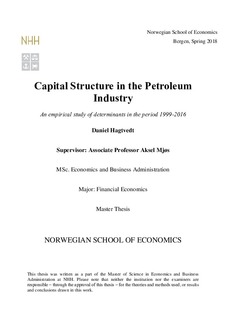Capital structure in the petroleum industry : an empirical study of determinants in the period 1999-2016
Master thesis
Permanent lenke
http://hdl.handle.net/11250/2561182Utgivelsesdato
2018Metadata
Vis full innførselSamlinger
- Master Thesis [4372]
Sammendrag
This thesis studies the determinants of capital structure in global independent petroleum
exploration and production (E&P) firms in the period 1999-2016. I have used two definitions
of leverage; (i) Debt-to-Assets, and (ii) Debt-to-Capital. Both definitions are expressed using
book and market values, giving four different dependent variables to analyse.
The three most popular capital structure theories among academics have been tested; (1)
Trade-off theory, (2) Pecking Order theory, and (3) Market Timing theory. Based on multiple
regression models using fixed effects estimation I identify six firm-specific factors that
reliably determines capital structure in E&P firms; profitability (-), credit rating (+), lagged
leverage ratio (+), market-to-book assets ratio (-), asset tangibility (+), and reserve
replacement ratio (+). The inclusion of macroeconomic factors does not add any considerable
value to the regression models. However, I have identified five macroeconomic factors that
tend to determine capital structure for E&P firms; oil (-), MSCI (+), GDP (+), term spread
(+), and E&P capital expenditures (+).
Furthermore, this thesis is aimed at finding differences in capital structure determinants
between oilfield services firms (OFS) and E&P firms. I identify four firm-specific factors that
reliably determines capital structure in OFS firms; non-debt tax shield (-), tangibility (+),
median industry leverage (+), and lagged leverage ratio (+). Most of the included
macroeconomic factors are significant for OFS, although with opposite signs compared to
E&P. I hence find evidence that leverage in the E&P sector is pro-cyclical, while it is
counter-cyclical in the OFS sector.
Based on the empirical evidence, it seems that neither of the main theories are fully able to
predict capital structure. However, the results suggest that both the trade-off and pecking
order theory are about equally accurate in explaining capital structure decisions for both E&P
and OFS firms.
